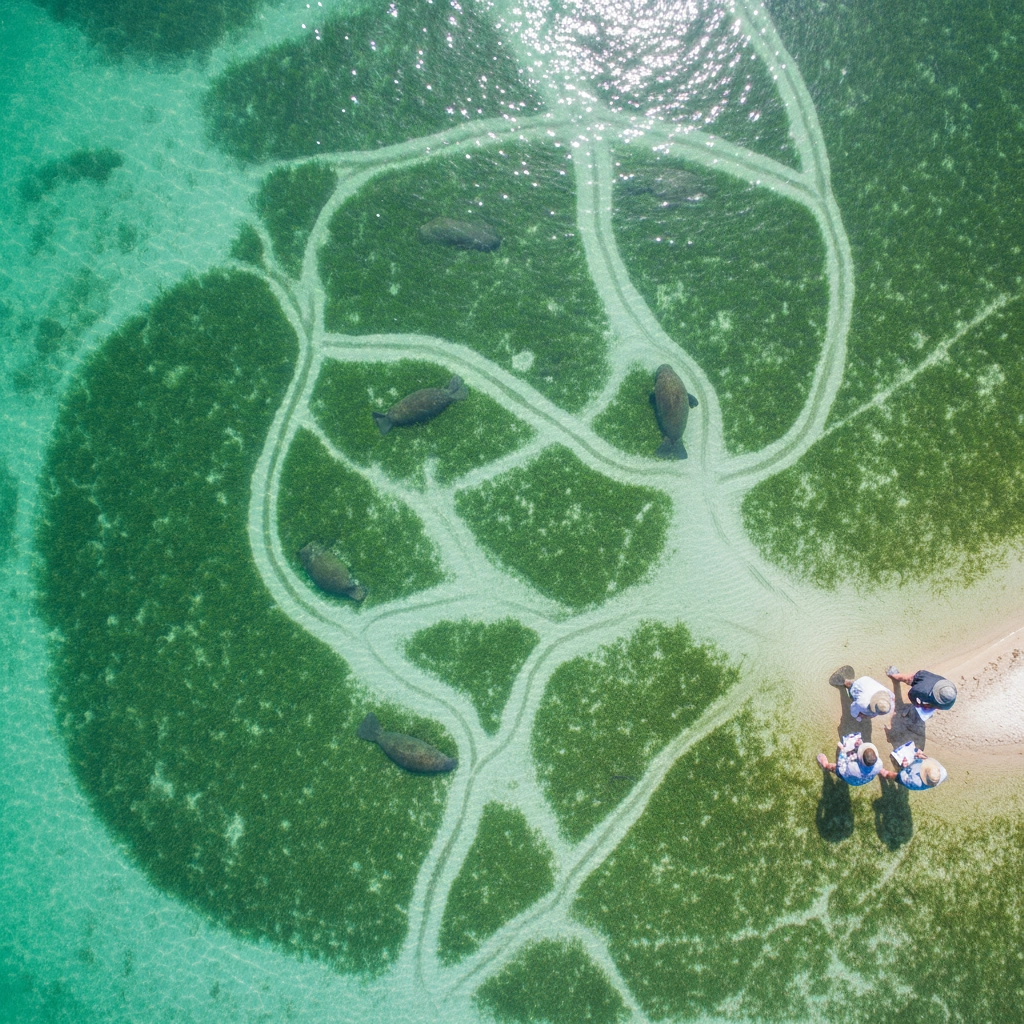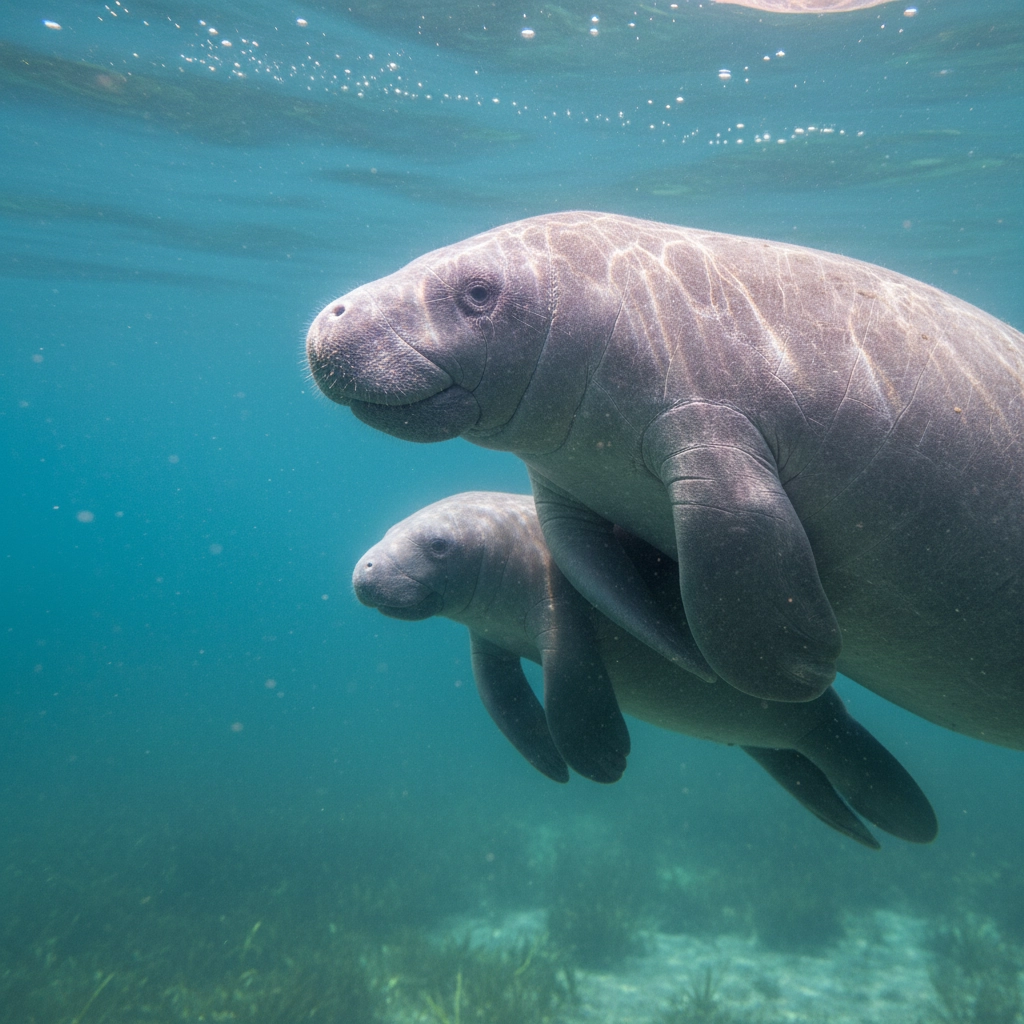Crystal River Manatees: Uncovering the Biology of Florida's Gentle Giants
- Caleb Mullenix
- 2 days ago
- 5 min read
Crystal River represents one of North America's most exceptional outdoor classrooms for studying marine mammal biology. Designated as the "Manatee Capital of the World," this pristine Florida ecosystem offers educators an unparalleled opportunity to engage students with living science. Understanding manatee biology through direct observation transforms abstract concepts into unforgettable learning experiences that inspire lifelong environmental stewardship.
Why Crystal River Creates the Perfect Manatee Laboratory
Crystal River's unique geological features establish it as an essential habitat for West Indian manatees, making it an ideal location for student research expeditions. The region's natural spring system, fed by the Floridan Aquifer, maintains a constant temperature of 72°F year-round: a critical factor in manatee survival that demonstrates the intersection of geology and biology.
During winter months, when offshore Gulf waters drop below 68°F, manatees cannot survive in the open ocean due to their unique physiological constraints. This creates predictable aggregation patterns that allow students to observe up to 400 manatees simultaneously in Kings Bay and Three Sisters Springs. These thermal refuges provide living examples of habitat selection, physiological adaptation, and species survival strategies.
The consistent year-round manatee population in Crystal River: approximately 25% of the entire U.S. manatee population: offers students opportunities to study both seasonal migration patterns and resident behavior. This concentration of marine mammals in a controlled, accessible environment creates optimal conditions for structured scientific observation and data collection.

Manatee Anatomy: Adaptations for Aquatic Life
Manatee anatomy reveals remarkable adaptations that demonstrate evolutionary biology principles. These gentle giants typically weigh 800-1,200 pounds, with some individuals reaching up to 1,500 pounds and measuring 10-12 feet in length. Their torpedo-shaped bodies minimize drag while swimming, illustrating form-and-function relationships that students can observe directly.
The manatee's skeletal system provides excellent examples of convergent evolution. Their flippers contain the same bone structure as human hands: complete with five digits: demonstrating mammalian homology. Students can compare manatee flipper bones to their own hand bones, reinforcing concepts of evolutionary relationships and comparative anatomy.
Manatees possess dense bones that act as ballast, helping them maintain neutral buoyancy in shallow waters. This adaptation allows them to rest motionlessly on the bottom while conserving energy: a behavior students frequently observe during field studies. The absence of blubber, unlike other marine mammals, reflects their tropical origins and warm-water habitat requirements.
Their respiratory system demonstrates adaptation to semi-aquatic life. Manatees must surface every 3-5 minutes to breathe, though they can hold their breath for up to 20 minutes when resting. Students can time breathing intervals and correlate activity levels with respiratory patterns, creating quantitative data sets for analysis.
Feeding Ecology: Herbivorous Giants
Manatee feeding behavior provides exceptional opportunities for students to study herbivore ecology and energy flow in aquatic ecosystems. These massive marine mammals consume approximately 10% of their body weight daily: roughly 100-150 pounds of vegetation for an average adult. This extraordinary consumption rate demonstrates the energy requirements of large herbivores and their impact on ecosystem dynamics.
Students can observe manatees feeding on seagrass beds, witnessing firsthand how herbivores shape their environment. Manatee feeding creates "feeding trails" in seagrass meadows, which students can map and measure to quantify herbivore impact on primary producers. This activity integrates marine botany with animal behavior studies.

The manatee digestive system reflects herbivorous adaptations, with an exceptionally long intestinal tract: up to 130 feet: that maximizes nutrient extraction from low-quality plant material. Students can compare manatee digestive anatomy to carnivorous marine mammals, reinforcing concepts of evolutionary specialization and ecological niche partitioning.
Manatees spend 6-8 hours daily foraging, a behavior pattern students can document through systematic observation. This time-budget analysis introduces concepts of optimal foraging theory and energy allocation in wild animals.
Reproductive Biology and Life History
Manatee reproduction demonstrates slow-paced life history strategies typical of large mammals. Female manatees reach sexual maturity at 4-5 years of age, with gestation lasting 12-14 months. Students studying manatee populations can observe mother-calf pairs, documenting nursing behavior and maternal care strategies.
Calves remain with their mothers for 1-2 years, providing extended opportunities for students to observe mammalian parenting behavior. The strong bond between mothers and calves demonstrates investment in offspring survival: a key concept in life history theory. Students can identify individual manatees through natural markings, creating long-term behavioral studies.
Manatees typically produce single calves every 2-5 years, reflecting the slow reproductive rate characteristic of K-selected species. This reproductive strategy helps explain manatee vulnerability to human impacts and the importance of conservation efforts. Students can calculate population growth rates and model recovery scenarios using real demographic data.

Thermoregulation: A Critical Survival Challenge
Manatee thermoregulation provides compelling examples of physiological ecology and environmental constraints on species distribution. Manatees exhibit an unusually low metabolic rate: 36% below predicted values for mammals their size. While this energy-efficient metabolism conserves resources, it creates vulnerability to cold temperatures.
Students can measure water temperatures in different areas of Crystal River, documenting the thermal gradients that influence manatee distribution. Temperature mapping activities demonstrate how physical environmental factors directly determine animal behavior and habitat selection.
During cold snaps, students can observe dramatic behavioral changes as manatees concentrate in warm-water springs. These aggregations provide real-time examples of behavioral thermoregulation and stress responses in wild populations. Students can correlate weather data with manatee distribution patterns, creating testable hypotheses about animal responses to environmental change.
Conservation Biology in Action
Crystal River offers students direct engagement with conservation challenges facing endangered species. Despite protection under the Marine Mammal Protection Act and Endangered Species Act, manatee populations face ongoing threats from boat strikes, habitat loss, and water quality degradation.
Students can participate in citizen science programs, collecting data on manatee injuries, behavior, and distribution. These activities demonstrate how scientific research informs conservation policy and management decisions. Photo-identification studies allow students to contribute to long-term population monitoring while learning research methodologies.
Water quality monitoring provides opportunities to study human impacts on marine ecosystems. Students can test water parameters and correlate results with seagrass health and manatee distribution, demonstrating ecosystem interconnections and human environmental impacts.

Behavioral Studies: Social Structure and Communication
Manatee social behavior offers insights into mammalian behavioral ecology. Although generally solitary, manatees exhibit complex social interactions during feeding, mating, and thermal aggregations. Students can document social behaviors, creating ethograms and analyzing interaction patterns.
Manatee communication includes vocalizations, tactile contact, and chemical signals. Students using hydrophones can record manatee vocalizations, analyzing acoustic communication patterns. This technology integration demonstrates modern research methods while providing hands-on experience with scientific equipment.
Individual recognition studies teach students about animal behavior research methodologies. By learning to identify individual manatees through scars, markings, and physical characteristics, students develop observational skills essential for scientific research.
Creating Transformative Learning Experiences
Crystal River manatee studies integrate multiple scientific disciplines: marine biology, ecology, conservation science, animal behavior, and environmental science: into cohesive learning experiences. Students engage with living systems while developing research skills, scientific thinking, and environmental awareness.
Field studies in Crystal River provide opportunities for authentic scientific research, data collection, and hypothesis testing. Students emerge from these experiences with deeper understanding of scientific methodology, marine ecosystem function, and conservation challenges facing endangered species.
The biological complexity of manatees: from cellular physiology to ecosystem interactions: creates opportunities for differentiated learning that accommodates various student interests and academic levels. Advanced students can pursue independent research projects while beginning students focus on fundamental biological concepts.
Ensure your students experience the transformative power of field-based learning through carefully planned expeditions that combine rigorous academics with unforgettable natural encounters. Appleseed Expeditions specializes in creating educational adventures that bring curriculum to life, transforming students into confident scientific thinkers and environmental stewards through direct engagement with Florida's remarkable marine ecosystems.



Comments